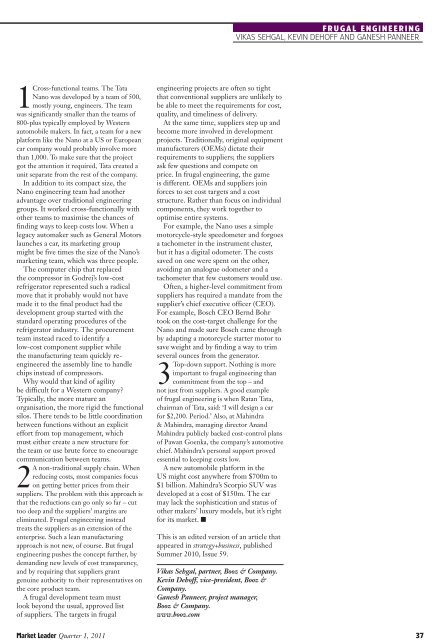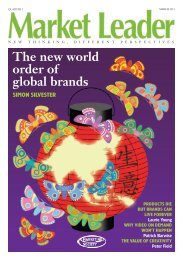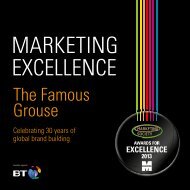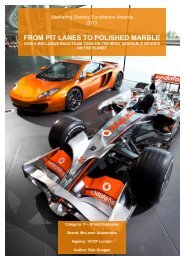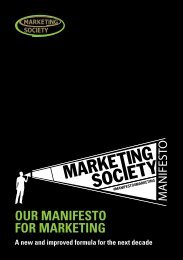MARKET LEADER q1 11 COVER draft 1.indd - The Marketing Society
MARKET LEADER q1 11 COVER draft 1.indd - The Marketing Society
MARKET LEADER q1 11 COVER draft 1.indd - The Marketing Society
You also want an ePaper? Increase the reach of your titles
YUMPU automatically turns print PDFs into web optimized ePapers that Google loves.
F R U G A L e n G I n e e R I N G<br />
Vikas Sehgal, Kevin Dehoff and Ganesh Panneer<br />
1Cross-functional teams. <strong>The</strong> Tata<br />
Nano was developed by a team of 500,<br />
mostly young, engineers. <strong>The</strong> team<br />
was significantly smaller than the teams of<br />
800-plus typically employed by Western<br />
automobile makers. In fact, a team for a new<br />
platform like the Nano at a US or European<br />
car company would probably involve more<br />
than 1,000. To make sure that the project<br />
got the attention it required, Tata created a<br />
unit separate from the rest of the company.<br />
In addition to its compact size, the<br />
Nano engineering team had another<br />
advantage over traditional engineering<br />
groups. It worked cross-functionally with<br />
other teams to maximise the chances of<br />
finding ways to keep costs low. When a<br />
legacy automaker such as General Motors<br />
launches a car, its marketing group<br />
might be five times the size of the Nano’s<br />
marketing team, which was three people.<br />
<strong>The</strong> computer chip that replaced<br />
the compressor in Godrej’s low-cost<br />
refrigerator represented such a radical<br />
move that it probably would not have<br />
made it to the final product had the<br />
development group started with the<br />
standard operating procedures of the<br />
refrigerator industry. <strong>The</strong> procurement<br />
team instead raced to identify a<br />
low-cost component supplier while<br />
the manufacturing team quickly reengineered<br />
the assembly line to handle<br />
chips instead of compressors.<br />
Why would that kind of agility<br />
be difficult for a Western company?<br />
Typically, the more mature an<br />
organisation, the more rigid the functional<br />
silos. <strong>The</strong>re tends to be little coordination<br />
between functions without an explicit<br />
effort from top management, which<br />
must either create a new structure for<br />
the team or use brute force to encourage<br />
communication between teams.<br />
2<br />
A non-traditional supply chain. When<br />
reducing costs, most companies focus<br />
on getting better prices from their<br />
suppliers. <strong>The</strong> problem with this approach is<br />
that the reductions can go only so far – cut<br />
too deep and the suppliers’ margins are<br />
eliminated. Frugal engineering instead<br />
treats the suppliers as an extension of the<br />
enterprise. Such a lean manufacturing<br />
approach is not new, of course. But frugal<br />
engineering pushes the concept further, by<br />
demanding new levels of cost transparency,<br />
and by requiring that suppliers grant<br />
genuine authority to their representatives on<br />
the core product team.<br />
A frugal development team must<br />
look beyond the usual, approved list<br />
of suppliers. <strong>The</strong> targets in frugal<br />
engineering projects are often so tight<br />
that conventional suppliers are unlikely to<br />
be able to meet the requirements for cost,<br />
quality, and timeliness of delivery.<br />
At the same time, suppliers step up and<br />
become more involved in development<br />
projects. Traditionally, original equipment<br />
manufacturers (OEMs) dictate their<br />
requirements to suppliers; the suppliers<br />
ask few questions and compete on<br />
price. In frugal engineering, the game<br />
is different. OEMs and suppliers join<br />
forces to set cost targets and a cost<br />
structure. Rather than focus on individual<br />
components, they work together to<br />
optimise entire systems.<br />
For example, the Nano uses a simple<br />
motorcycle-style speedometer and forgoes<br />
a tachometer in the instrument cluster,<br />
but it has a digital odometer. <strong>The</strong> costs<br />
saved on one were spent on the other,<br />
avoiding an analogue odometer and a<br />
tachometer that few customers would use.<br />
Often, a higher-level commitment from<br />
suppliers has required a mandate from the<br />
supplier’s chief executive officer (CEO).<br />
For example, Bosch CEO Bernd Bohr<br />
took on the cost-target challenge for the<br />
Nano and made sure Bosch came through<br />
by adapting a motorcycle starter motor to<br />
save weight and by finding a way to trim<br />
several ounces from the generator.<br />
3Top-down support. Nothing is more<br />
important to frugal engineering than<br />
commitment from the top – and<br />
not just from suppliers. A good example<br />
of frugal engineering is when Ratan Tata,<br />
chairman of Tata, said: ‘I will design a car<br />
for $2,200. Period.’ Also, at Mahindra<br />
& Mahindra, managing director Anand<br />
Mahindra publicly backed cost-control plans<br />
of Pawan Goenka, the company’s automotive<br />
chief. Mahindra’s personal support proved<br />
essential to keeping costs low.<br />
A new automobile platform in the<br />
US might cost anywhere from $700m to<br />
$1 billion. Mahindra’s Scorpio SUV was<br />
developed at a cost of $150m. <strong>The</strong> car<br />
may lack the sophistication and status of<br />
other makers’ luxury models, but it’s right<br />
for its market. n<br />
This is an edited version of an article that<br />
appeared in strategy+business, published<br />
Summer 2010, Issue 59.<br />
Vikas Sehgal, partner, Booz & Company.<br />
Kevin Dehoff, vice-president, Booz &<br />
Company.<br />
Ganesh Panneer, project manager,<br />
Booz & Company.<br />
www.booz.com<br />
Market Leader Quarter 1, 20<strong>11</strong> 37


